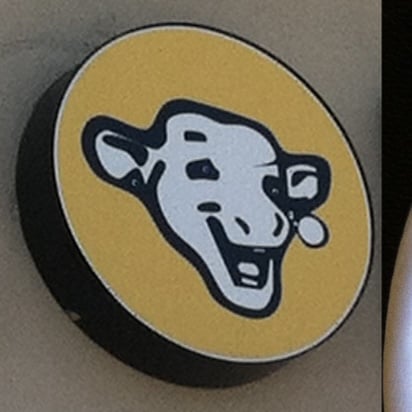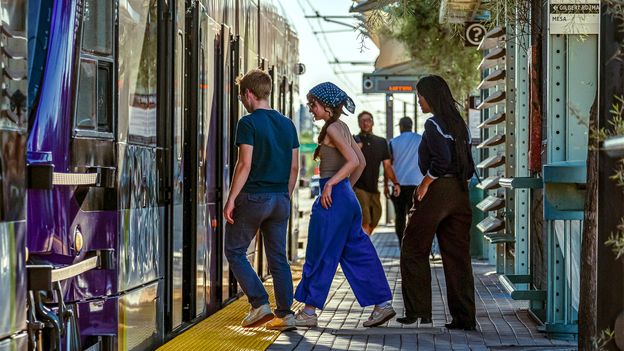You mean cheap and it’s always sunny?
Fun fact: Tempe is named after The Vale of Tempe in Greece.
I visited Culdesac last year to see CityNerd and Urban Phoenix Project talk about urban development. It’s a neat place. If it existed 10 years ago I would have liked to live there. Going car free in Phoenix is definitely a challenge but I’m glad some people are willing to try it.
Listened to Ryan Johnson talk about this, but still confused as to why it’s called Caldesac…the thing that completely lacks circuitry and connectivity.
Culdesac is a word for a stretch of street that has no through way, a dead end. The only reason to drive into it is if you are going to one of the houses.
Demonstrably autocentric development schemes.
Oh absolutely.
Tourism Greece or actual Greece? Probably just tourism Greece, i.e., a fake product we sell to foreigners.
The article talks about giving you the sense of community back since you’re closer to your neighbors and can hear them. We moved into a neighborhood that has no privacy fencing. Instead we have low open rail fencing. If my neighbors are playing cornhole in their yard I can literally talk to them from inside my house. It’s been awesome since we’ve gotten to know a lot of them.
deleted by creator
Tempe is probably the 1 place I would want a car. No one wants to walk around in 110°F / 43°C heat. I’ve traveled there a few times and it’s like being cooked in an oven
The article states that the smaller alleyways create breezes and since they’re more tightly packed it’s shaded almost all the time. Ends up being cooler.
Yeah. A shocking 30-40°F cooler. So it would be a slightly warm 80°F.
That’s insufferable by European standards but heaven by Arizona standards.
Which in Tempe is basically a miracle.
We need to implement the implement Wind Towers in the dry climates of the US. They wouldn’t help as a pedestrian, but they help to expel heat in buildings when it isn’t windy and to actively cool buildings when it is windy. This single piece of technology could desperately help the American Southwest.
Combine these with tighter buildings and local plant-life and people will be much better off.
As someone who just moved out of the Mesa, Arizona area. About 10 miles from here. And lived in AZ for around 25 years. A few points, It is hotter than Satan’s asshole after ghost pepper chilli night. Your cloths that you are wearing will be physically hot against your skin during summer, in about 5-10 minutes. The gap / crack-fill in the road becomes soft and malleable in summer. Sure there are things to do, but for the next 4-6 hours drive, you are going to the same place that many people are going to and you will be lucky to find anywhere not crowded or secluded. The rent a bike and scooter prices are not always great. It gets hot, like 85 Fahrenheit or more by April and it doesn’t begin to cool off until October - November. 110 Fahrenheit or more is insanely hot. The Urban Sprawl is huge, and combined with the intense heat, clouds go around most of the Sprawl. And unless you have a nice paying job and your shit together, you can’t afford to live here. But the light rail and the self driving cars are kinda cool.
edit: Holy air pollution batman.
I don’t know how anyone could feel transported by being here. Its literally a single block of “car free” neighborhood development. Outside of that its your standard US city with subpar public transport, little in the way of pedestrian or bike infrastructure, and its very car centric. I think if the neighborhood was self sufficient and was of a size where most of your needs could be found within its boundaries then it could work. It would need to be much much larger for that though. Unfortunately that can’t happen because they have 1500ft or so on their block and all the land around them is developed.
literally a single block
But the article says
17-acre
A city block is anywhere from 2-5 acres, so you’re not far off, but it’s 3-8 times bigger than your description makes it seem.
As a comparison, Union Square in SF is 2.6 acres, so Culdesac would be over 6 times the area of Union Square. That’s definitely not a huge area, but in a place like Tempe it must feel like an oasis for those of us who hate suburban sprawl.
My hope is that places like this inspire more areas like this to be created when redeveloping. Anything that reduces suburban car-centric sprawls is good in my book. Even if just a little bit.
I guess to put it another way, the world seems a little bit better with this place in it instead of a 12 acre parking lot next to a 7 acre building, which is the kind of thing that exists all around my little town. We don’t even have a downtown, just a highway with strip malls.
that 17 acres is being very generous, most of that land is dirt and has been for over a year with no signs of recent development. The actual useable area is a generous 6 acres and has none of the height from most downtown city blocks, the buildings are only three stories tall and mostly just residences. It’s more an apartment complex with some corner stores
This development is specifically made so that necessities are within the community.
Greece? What Greece? Where???
The parts that tourists visit.
Mackinac Island?
Horse shit and fudge.
I think this is very interesting! I’d love to check it out sometime.
I want to believe this is good, but something about it smells of late stage capitalism.
In Tempe, Arizona, Culdesac is reimagining US cities for people, not cars – and inviting travellers to explore its plazas, paseos and Mediterranean-inspired design.
A town in the desert that says no cars is like asking for a spike in heat stroke.
That’s why they designed the development to passively cool the walkways.








